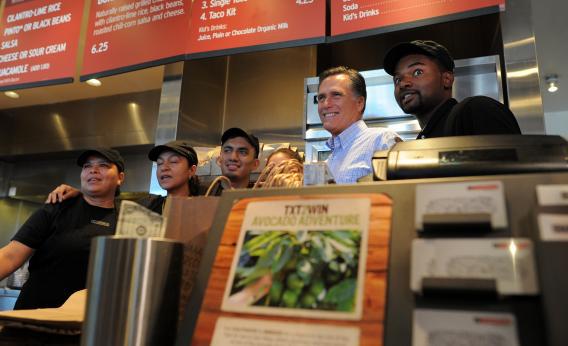It was a little more than a year ago that I wrote a column hailing Chiptole as a kind of high-tech innovator, part of my long-term campaign to get the world to take food service seriously as an economic sector. This line of thinking was not so well-loved by Bay Area burrito snobs which, ironically, helped turn the column into a hit since some of the aforementioned snobs denounced it on high-traffic tech sites. Today, thanks to the good offices of mutual friend Spencer Ackerman I sat down with Wired’s Matthew Honan and Caitlin Roper at La Taqueria in San Francisco for a historic burrito summit.
How did it go? And what can we learn about burritos? And the economy?
I was glad that Honan picked La Taqueria as the location because the name of the establish underscores one of the more curious facts about the San Francisco burrito culture, namely that the burrito-selling establishments are called “taquerias”. You would think a taqueria would specialize in tacos, but to each his own. At any rate, La Taqueria does clearly sell tacos and in fact this guy was making one.
But I was here for the burritos. You order them off this menu that, inconveniently, is not actually visible from where the line forms when the place is busy. But I was here as Honan’s guest, so I deferred to his ordering opinions and went for a carne asada burrito.
The presentation is very similar to chipotle, but the actual burrito is slimmer.
Unwrapped you can see that the slimmer profile gives it a greater structural integrity.
Bite in, and you see La Taqueria’s key advantage over Chipotle—the ingredients are blended together in a superior manner rather than awkwardly stacked as tends to be the case at the fast food place.
Delicious!
All things considered, La Taqueria is offering a better burrito. But Chipotle is offering a better burrito-based business proposition. Chipotle has better-designed spaces, with greater menu visibility and superior clarity as to what your options are. Chipotle’s lines move substantially faster. Your mileage may vary as to the merits of a prudent slim burrito vs Chipotle’s mega-calorie bomb, but in some sense Chipotle is offering a better value proposition. More realistically though if a burrito was to materialize at my desk I would want it to be a La Taqueria burrito.
But Chipotle brings us exactly what innovators have always brought us. Not the very best product in the world, but the very best production process allowing for large-scale distrbution of a quality product. Mass produced clothing isn’t as good as tailor-made, but a world in which mass produced clothing is available is a much better and more prosperous world than a world of handmade clothing. Artisans like the proprietors of La Taqueria make enormous contributions to their communities, but entrepreneurs and mass producers like Chipotle make enormous contributions to the whole world by bringing great ideas to scale. That said, last week I saw something in Texas that’s arguable even more amazing than Chipotle’s assembly line approach to burritos—the tortilla machine at Taco Cabana in Texas. If they manage to break out of their home region, it could be a total game changer.
